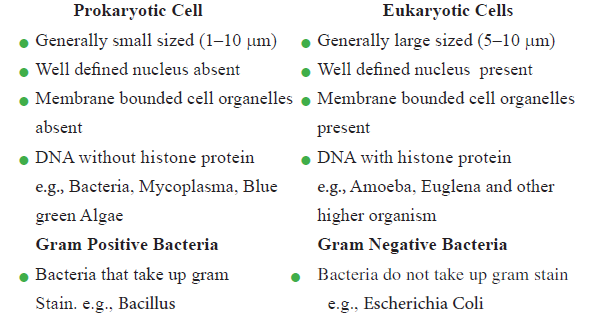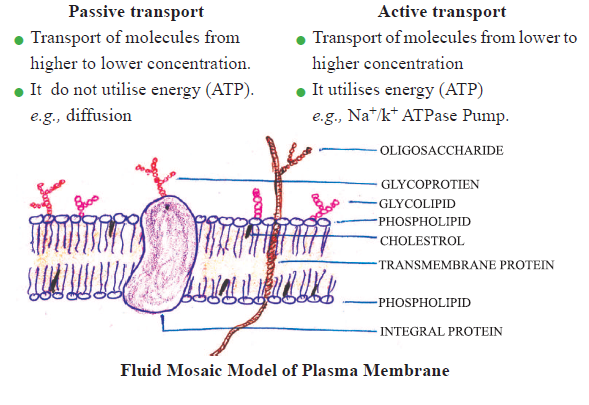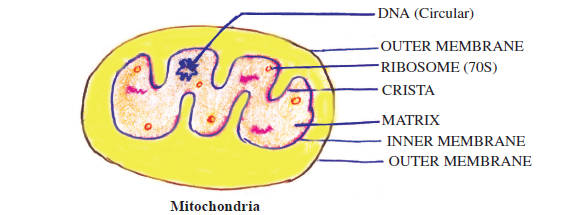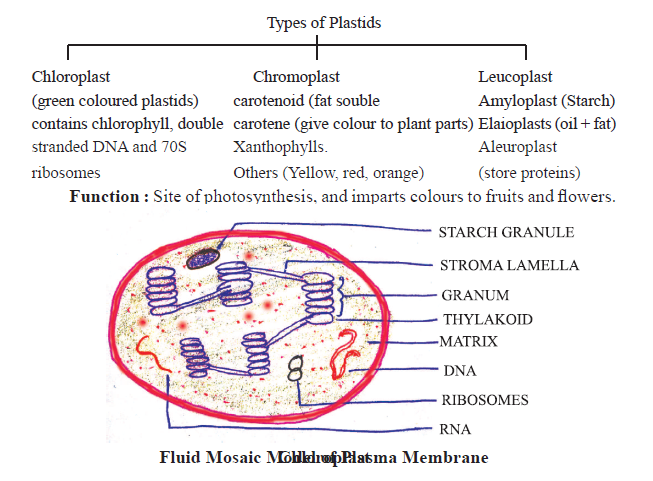Download CBSE Class 11 Biology Cell The Unit Of Life Notes Set B in PDF format. All Revision notes for Class 11 Biology have been designed as per the latest syllabus and updated chapters given in your textbook for Biology in Class 11. Our teachers have designed these concept notes for the benefit of Class 11 students. You should use these chapter wise notes for revision on daily basis. These study notes can also be used for learning each chapter and its important and difficult topics or revision just before your exams to help you get better scores in upcoming examinations, You can also use Printable notes for Class 11 Biology for faster revision of difficult topics and get higher rank. After reading these notes also refer to MCQ questions for Class 11 Biology given on studiestoday
Revision Notes for Class 11 Biology Chapter 8 Cell The Unit of Life
Class 11 Biology students should refer to the following concepts and notes for Chapter 8 Cell The Unit of Life in Class 11. These exam notes for Class 11 Biology will be very useful for upcoming class tests and examinations and help you to score good marks
Chapter 8 Cell The Unit of Life Notes Class 11 Biology
Points to Remember
Cell Theory : Cell Theory was formulated by Schleiden and Schwann, and was modified by Rudolf Virchow. Cell theory States.
(A) All living organisms are composed of cells and products of cells.
(B) All cells arise from pre-existing cells.
Cell : Cell is the structural and functional unit of life.

PROKARYOTIC CELL :
Modification of cell envelope
Slime layer : Glycocalyx in form of loose sheath.
Capsule : Glycocalyx in form of thick and tough sheath.
Mesosomes : Extension of plasma membrane. These can be in the form of vesicles, tubules and lamellae.
Functions: Cell wall formation, DNAreplication and distribution to daughter cells, respiration, secretion processes, to increase surface area of plasma membrane and enzyme content.
Flagella: Extension of cell wall. It is composed of three structure-filament, hook and basal body. It help in motility of bacteria.
Pili and fimbriae : Surface structure of some bacteria which attaches them to rocks in streams and to host tissues.
Genetic Material: It is not covered by nuclear envelope. In addition to the genomic DNA (the single chromosome/circular DNA), many bacteria have small circular self replicating, double straned DNA which is called as plasmid, plasmid contain genes like antibiotic resistance.
Eukaryotic cells
Possess an oragnized nucleus with nuclear envelope and have a variety of complex locomotory and cytoskeletal structures.
Cell Membrane – Singer and Nicolson (1972) gave ‘fluid mosaic model’. According to this the quasi-fluid nature of lipid enables lateral movement of proteins within the overall bilayer; two types of proteins (Peripheral and integral proteins) with cholesterol, glycolipids and glycoporteins. Erythrocyte membrane has 52% protein and 40% lipids.
Function- It is semi permeable and helps in transport of molecule across it.

Cell The Unit of Life
Cell Wall is non-living rigid structure which gives shape to the cell and protects cell from mechanical damage and infection, helps in cell-to-cell interaction and provides barrier to undesirable macromolecules.
Cell wall of algae is made of cellulose, galactans, mannans and minerals like calcium carbonate. Plant cell wall consists of cellulose, hemicellulose, pectins and proteins.
Middle lamella is made of calcium pectate which holds neighbouring cells together.
Plasmodesmata connect the cytoplasm of neighbouring cells.
Endoplasmic Reticulum (ER)
Consists of network of tiny tubular structure. ER divides the intracellular space into two distinct compartments-luminal (inside ER) and extra luminal (cytoplasm).
(i) Rough Endoplasmic Reticulum (RER) :
Ribosomes attached to outer surface.
Function : Involved in protein synthesis and secretion.
(ii) Smooth Endoplasmic Reticulum (SER) :
Lack ribosomes.
Function : Site for synthesis of lipid.
Golgi apparatus: First observed by Camillo Golgi (in 1898)
Consist of cisternae stacked parallel to each other. Two faces of the organelle are convex/cis or forming face and concave/trans or maturing face.
Functions : Performs packaging of materials, to be delivered either to the intra-cellar targets or secreted outside the cell. Important site of formation of glycoproteins and glycolipids.
Lysosomes: Membrane bound vesicular structures formed by the process of packaging m the golgi apparatus. Contain hydrolysing enzymes (lipases, proteases, carbohydroses) which are active in acidic pH. Also called ‘Suicidal Bag’.
Function : Intracellular digestion.
Vacuoles : Member bound space found in the cytoplasm. Contain water, sap, excretory product, etc. In plant cell, vacoule occupies 90% of space.
Function : In plants tonoplast (single membrane of vacuole) faciliates transport of ions and other substances.
Contractile vacuole for excretion in Amoeba and food vacuoles formed in protists for digestion of food.
Mitochondria : Double membraned structure. Outer membrane smooth and inner membrane forms a number of infoldings called cristae The inner compartment is called matrix. The cristae increase the surface area.

Cell The Unit of Life
Function : Sites of aerobic respiration. Called ‘power houses’ of cell as produce cellular energy in the form ofATP. Matrix possesses single circular DNA molecule, a few RNA molecules, ribsomes (70S). It divides by binary fission.
Plastids : Found in plant cells and in euglenoides. Chloroplasts, chromoplasts and leucoplasts are 3 types of plastids depending on pigments contained.

Cell The Unit of Life
Ribosomes
Composed of RNA and proteins; without membrane. Eucaryotic ribosomes are 80S. S = Svedberg’s unit)
Function : Site of protein synthesis.
Cytoskeleton: Network of filaments.
Proteinaceous structure in cytoplasm made up of microtubules and micro filaments.
Function : Mechanical support, motility, maintenance of the shape of the cell.
Cilia and Flagella
Cilia are small structures which work like oars which help in movement. Flagella are longer and responsible for cell movement. They are covered with a plasma membrane. Core is called axoneme which has 9 + 2 arrangement of axonemal microtubules.
Centrosome and Centrioles
Centrosome contains two cylindrical structures called centrioles. Surrounded by amorphous pericentriolar material. Has 9 + 2 arrangement. Centrioles form the basal body of cilia or flagella and spindle fibres for cell division in animal cells. They produces spindle apparatus during cell divison.
Nucleus: With double membrane with perinuclear space and nuclear pores; has Chromatin, nuclear matrix and nucleoli (site for rRNA synthesis). (Named by Robert Brown – 1831)
Chromatin DNA+ nonhistone proteins. (Named by Flemming)
Nucleoplasm- Nucleolus+ Chromatin
Nulear membrane- It is with perinuclear space and nucleopores.
Chromosomes- DNA/RNA + Histone protein/Nonhistone protein.
Centromere : Primary constriction-disc is known as kinetochores.
No nucleus in Erythrocyctes (RBC) of mammals and sieve tubes in vascular plants.
Chromosomes (on basis of position of centromere) :
Metacentric : Middle centromere.
Sub-metacentric : Centromere nearer to one end of chromosomes. Acrocentric : Centromere situated close to its end.
Telocentric : Has terminal centromere.
Satellite : Some chromosomes have non-staining secondary constructions at a constant location, which gives the appearance of small fragment called satellite.
| CBSE Class 11 Biology The Living World Notes Set A |
| CBSE Class 11 Biology The Living World Notes Set B |
| CBSE Class 11 Biology Plant Kingdom Notes Set A |
| CBSE Class 11 Biology Plant Kingdom Notes Set B |
| CBSE Class 11 Biology Plant Kingdom Notes Set C |
| CBSE Class 11 Biology Animal Kingdom Notes Set A |
| CBSE Class 11 Biology Animal Kingdom Notes Set B |
| CBSE Class 11 Biology Animal Kingdom Notes Set C |
| CBSE Class 11 Biology Morphology Of Flowering Plants Notes Set A |
| CBSE Class 11 Biology Morphology Of Flowering Plants Notes Set B |
| CBSE Class 11 Biology Structural Organisation In Animals Notes Set A |
| CBSE Class 11 Biology Structural Organisation In Animals Notes Set B |
| CBSE Class 11 Biology Cell The Unit Of Life Notes Set A |
| CBSE Class 11 Biology Cell The Unit Of Life Notes Set B |
| CBSE Class 11 Biology Cell The Unit Of Life Notes Set C |
| CBSE Class 11 Biology Biomolecules Notes Set A |
| CBSE Class 11 Biology Biomolecules Notes Set B |
| CBSE Class 11 Biology Respiration In Plants Notes Set A |
| CBSE Class 11 Biology Respiration In Plants Notes Set B |
| CBSE Class 11 Biology Plant Growth And Development Notes Set A |
| CBSE Class 11 Biology Plant Growth And Development Notes Set B |
| CBSE Class 11 Biology Breathing And Exchange Of Gases Notes Set A |
| CBSE Class 11 Biology Breathing And Exchange Of Gases Notes Set B |
| CBSE Class 11 Biology Body Fluids And Circulation Notes Set A |
| CBSE Class 11 Biology Body Fluids And Circulation Notes Set B |
| CBSE Class 11 Biology Neural Control And Coordination Notes Set A |
| CBSE Class 11 Biology Neural Control And Coordination Notes Set B |
| CBSE Class 11 Biology Chemical Coordination and Integration Notes Set A |
| CBSE Class 11 Biology OTBA Guidance Document Set A |
| CBSE Class 11 Biology OTBA Guidance Document Set B |
CBSE Class 11 Biology Chapter 8 Cell The Unit of Life Notes
We hope you liked the above notes for topic Chapter 8 Cell The Unit of Life which has been designed as per the latest syllabus for Class 11 Biology released by CBSE. Students of Class 11 should download and practice the above notes for Class 11 Biology regularly. All revision notes have been designed for Biology by referring to the most important topics which the students should learn to get better marks in examinations. Our team of expert teachers have referred to the NCERT book for Class 11 Biology to design the Biology Class 11 notes. After reading the notes which have been developed as per the latest books also refer to the NCERT solutions for Class 11 Biology provided by our teachers. We have also provided a lot of MCQ questions for Class 11 Biology in the notes so that you can learn the concepts and also solve questions relating to the topics. We have also provided a lot of Worksheets for Class 11 Biology which you can use to further make yourself stronger in Biology.
You can download notes for Class 11 Biology Chapter 8 Cell The Unit of Life for latest academic session from StudiesToday.com
Yes, the notes issued for Class 11 Biology Chapter 8 Cell The Unit of Life have been made available here for latest CBSE session
There is no charge for the notes for CBSE Class 11 Biology Chapter 8 Cell The Unit of Life, you can download everything free of charge
www.studiestoday.com is the best website from which you can download latest notes for Chapter 8 Cell The Unit of Life Biology Class 11
Come to StudiesToday.com to get best quality topic wise notes for Class 11 Biology Chapter 8 Cell The Unit of Life

